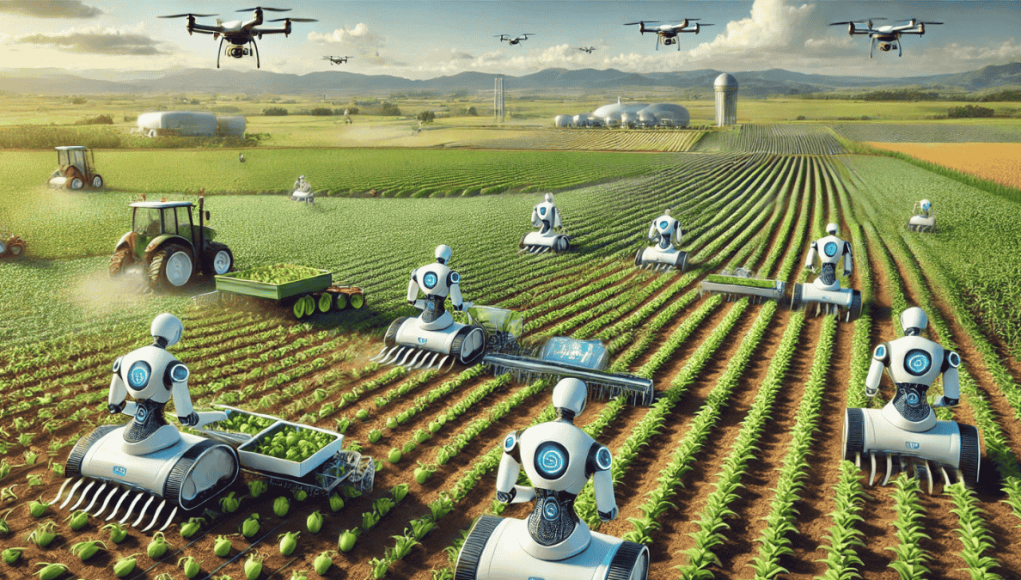The agriculture industry is undergoing a technological revolution, with Best AI Tools for Agricultural Robotics leading the charge. These tools not only reduce manual labor but also ensure precise farming operations. The combination of artificial intelligence (AI) and robotics enables farmers to perform tasks like planting, weeding, and harvesting with greater efficiency and accuracy. With AI, these tools can make real-time decisions based on data from sensors, drones, and satellites, optimizing crop yields while minimizing resource wastage. This article reviews some of the best AI tools for agricultural robotics, explaining how they can benefit farmers and what to consider when choosing them.
Why Agricultural Robotics Matter?
AI and robotics are transforming traditional farming methods into smart farming systems, which integrate advanced technologies to automate tasks such as seeding, fertilizing, and pest control. These tools can reduce human errors and operational costs while also addressing labor shortages that many agricultural sectors face. Furthermore, AI-powered robots improve environmental sustainability by optimizing water, fertilizer, and pesticide use, resulting in healthier soils and crops with fewer chemicals. As farming demands increase globally, these AI-driven solutions play a vital role in meeting food production needs sustainably and efficiently.
Best AI Tools for Agricultural Robotics
The following section reviews 15 of the top AI tools that are reshaping agricultural robotics, helping farmers achieve precision farming and improving crop productivity.
1. Carbon Robotics’ LaserWeeder
Overview:
Carbon Robotics’ LaserWeeder is an advanced AI-powered robot designed to control weeds using lasers, rather than herbicides. It employs computer vision and deep learning algorithms to detect and eliminate weeds with precision. This tool is ideal for large-scale farms needing to reduce chemical use and labor costs in weed management.
Features:
- AI-powered deep learning algorithms for weed detection.
- Computer vision for precise targeting.
- Laser technology to eliminate weeds without herbicides.
- Works on over 40 crop types.
- High precision, targeting up to 5,000 weeds per minute.
- Can cover two acres per hour.
- Reduces weed control costs by up to 80%.
Pros:
- No need for chemicals, making it eco-friendly.
- Cost-effective in the long run.
- Efficiently handles large-scale farms.
Cons:
- High initial investment.
- Requires technical knowledge for operation and maintenance.
2. Naïo Technologies’ Oz Robot
Overview:
The Oz Robot by Naïo Technologies is an autonomous robot designed for weeding and seeding tasks. Using AI and GPS-based navigation, it can operate without human intervention, providing precision in weeding and crop management, especially in small to medium-sized farms.
Features:
- Autonomous weeding with GPS navigation.
- AI-powered decision-making for seeding and weeding.
- Precision control for small fields.
- Real-time data collection for improved farm management.
- Battery-operated for sustainability.
- Can be programmed to work in different terrains.
Pros:
- Reduces labor costs significantly.
- Works efficiently in smaller farms.
- Environmentally friendly, using battery power.
Cons:
- Limited to small fields and specialized crops.
- May require specific training for use.
3. Blue River Technology’s See & Spray
Overview:
See & Spray by Blue River Technology, a subsidiary of John Deere, is a robotic system that uses computer vision and AI to distinguish between crops and weeds. It then precisely sprays herbicides only where needed, reducing chemical use by up to 90%.
Features:
- AI-powered computer vision for identifying weeds.
- Precision spraying to minimize herbicide use.
- Real-time data collection on field conditions.
- Reduces the environmental impact of farming.
- Compatible with large farms.
- High-speed weed detection system.
Pros:
- Reduces herbicide use and cost.
- Improves crop health by minimizing chemical exposure.
- Works on large-scale operations.
Cons:
- Limited to spraying; no other tasks.
- Expensive for smaller farms.
4. Harvest CROO Robotics
Overview:
Harvest CROO Robotics focuses on automating the strawberry harvesting process using AI and robotics. With labor shortages affecting many regions, this robot picks strawberries efficiently, ensuring quality and reducing reliance on human labor.
Features:
- AI-powered system for detecting ripe strawberries.
- Gentle harvesting to prevent damage to fruit.
- Can harvest a large field in one go.
- AI-based decision-making for harvest timing.
- Monitors plant health during harvesting.
Pros:
- Increases harvest speed.
- Reduces labor costs.
- Minimizes fruit damage.
Cons:
- Expensive setup costs.
- Limited to specific crops.
5. Ecorobotix
Overview:
Ecorobotix’s AI-powered autonomous robot is designed for precision fertilization and weed control. It uses AI algorithms to spray only the necessary amount of fertilizer or herbicide, reducing waste and ensuring environmentally friendly farming practices.
Features:
- AI-powered for precision spraying.
- Identifies specific weeds and plants.
- Minimal chemical use, reducing environmental impact.
- Solar-powered for sustainable operation.
- GPS navigation for autonomous work.
- Real-time data for better crop management.
Pros:
- Reduces chemical waste and cost.
- Solar-powered, making it eco-friendly.
- Ideal for organic and sustainable farming.
Cons:
- Best suited for small to medium farms.
- Requires ongoing monitoring for optimal performance.
6. FarmBot
Overview:
FarmBot is an AI-powered robotic farming system designed for smaller, urban, or controlled-environment farming. It automates tasks like planting, watering, and weeding, making it ideal for precision farming in small spaces.
Features:
- AI-driven for precision planting and watering.
- Automated weeding without chemicals.
- Customizable for different crops.
- Remote control through cloud software.
- Real-time monitoring and adjustments.
- Easy installation and low maintenance.
Pros:
- Suitable for small-scale and urban farms.
- Reduces manual labor significantly.
- Environmentally friendly.
Cons:
- Limited scalability for large farms.
- Relatively high cost for small operations.
7. AgXeed’s AgBot
Overview:
The AgBot from AgXeed is an autonomous robot designed for various farming operations such as tilling, seeding, and spraying. Using AI and data from multiple sources, the robot can perform tasks with minimal human intervention, improving precision and efficiency.
Features:
- AI-based navigation and task management.
- Performs multiple tasks like tilling, seeding, and spraying.
- Real-time data analysis for optimized farming.
- GPS-based autonomous operation.
- Reduces soil compaction with lightweight design.
- Works efficiently in large fields.
Pros:
- Handles multiple tasks, reducing labor.
- Optimizes resource use and increases yield.
- Lightweight, reducing soil damage.
Cons:
- High initial cost.
- Requires technical support for setup.
8. VineScout
Overview
VineScout is an AI-powered robot specifically designed for vineyard management. It helps optimize watering and harvesting by monitoring vine health and growth, ensuring optimal conditions for grape production.
Features:
- AI-powered sensors for vine health monitoring.
- Autonomous navigation in vineyards.
- Precision watering and harvesting recommendations.
- Real-time data for improved decision-making.
- Supports sustainable grape farming practices.
- Weather-resilient design.
Pros:
- Increases yield and quality of grapes.
- Saves time and labor.
- Eco-friendly, promoting sustainable practices.
Cons:
- Limited to vineyards.
- Expensive for small vineyards.
9. Thorvald Robots
Overview:
Developed by Saga Robotics, Thorvald Robots are multi-purpose farming robots designed to handle tasks like harvesting, spraying, and monitoring crop health. Their AI technology makes them versatile, with applications across various types of farms.
Features:
- AI-powered for multiple tasks including harvesting.
- Autonomous navigation and task execution.
- Can monitor crop health and optimize inputs.
- Weather-resistant for all-season operation.
- Real-time reporting for farm management.
- Modular design, allowing customization.
Pros:
- Versatile, handling various farm tasks.
- Improves efficiency and productivity.
- Suitable for different types of farms.
Cons:
- Requires a high investment.
- Not ideal for very small farms.
10. AeroFarms
Overview:
AeroFarms is a leader in vertical farming technology, utilizing AI-driven robotics to optimize crop production in controlled environments. Their farming systems incorporate machine learning and robotics to automate tasks like planting, watering, and harvesting in indoor spaces, making the most out of limited space while conserving resources.
Features:
- AI-powered climate control for indoor farming.
- Automated planting, watering, and nutrient application.
- Real-time monitoring of crop growth and health.
- Optimized use of water and nutrients to reduce waste.
- Data-driven adjustments for light, temperature, and humidity.
- Suitable for urban and controlled-environment agriculture.
- Supports sustainable and pesticide-free farming practices.
Pros:
- Ideal for space-constrained environments like urban farming.
- Reduces water consumption significantly.
- Pesticide-free production, promoting organic farming.
Cons:
- High initial setup costs.
- Limited to indoor or controlled environments.
11. ecoRobotix
Overview:
ecoRobotix is a solar-powered robot designed to offer precision spraying for crops, minimizing herbicide and pesticide usage. The robot uses AI to identify weeds and only sprays the necessary amount of chemicals, reducing both environmental impact and costs. It is ideal for large farms focusing on sustainable practices.
Features:
- AI-powered weed identification and precision spraying.
- Solar-powered for sustainable energy use.
- Reduces chemical usage by up to 90%.
- GPS-guided autonomous navigation.
- Real-time data collection for farm monitoring.
- Lightweight design to reduce soil compaction.
- Works on a wide variety of crops and terrains.
Pros:
- Environmentally friendly with low energy consumption.
- Drastically reduces the use of herbicides.
- Easy to operate and maintain.
Cons:
- Limited to weed control tasks.
- Not be suitable for small farms due to cost.
12. Iron Ox
Overview:
Iron Ox uses AI and robotics to manage all aspects of indoor farming, from seeding to harvesting. With a fully automated system, their robots monitor plant health and make data-driven decisions to ensure optimal growing conditions. Iron Ox focuses on sustainability by optimizing water and nutrient use.
Features:
- AI-driven monitoring of plant health.
- Automated systems for planting, watering, and harvesting.
- Data analysis for resource optimization.
- Autonomous robot arms for precision planting and care.
- Uses 90% less water than traditional farming.
- Real-time crop and environmental monitoring.
- Sustainable indoor farming model.
Pros:
- Significantly reduces water consumption.
- Fully automated for minimal human intervention.
- Ideal for urban and indoor farming.
Cons:
- Not suitable for outdoor or large-scale farming.
- High initial investment for the infrastructure.
13. Robotti by AgroIntelli
Overview:
The Robotti by AgroIntelli is an autonomous robot designed to handle multiple farming tasks, including seeding, weeding, and fertilizing. Using AI and precision farming techniques, Robotti improves efficiency by automating repetitive tasks, allowing farmers to focus on more strategic activities.
Features:
- Autonomous operation with AI-guided task management.
- Performs multiple tasks like seeding, weeding, and fertilizing.
- GPS-based navigation for precision farming.
- Data collection for real-time decision-making.
- Reduces labor costs and improves efficiency.
- Lightweight design to prevent soil compaction.
- Can be customized for different crops.
Pros:
- Handles a variety of farming tasks autonomously.
- Improves farm efficiency and reduces labor.
- Suitable for large farms looking for automated solutions.
Cons:
- Require technical training to operate.
- High cost for smaller farms.
14. Small Robot Company’s Tom, Dick, and Harry
Overview:
The Small Robot Company offers a unique set of autonomous farming robots, affectionately named Tom, Dick, and Harry. These robots work together to perform precision farming tasks such as planting, weeding, and monitoring crops. The system is designed to reduce soil compaction and optimize inputs for sustainable farming.
Features:
- Autonomous robots for planting (Harry), weeding (Dick), and monitoring (Tom).
- AI-driven decision-making for efficient crop management.
- Reduces chemical usage with precision weeding.
- Lightweight robots prevent soil compaction.
- Real-time data collection for crop health monitoring.
- Supports no-till farming practices.
- Environmentally friendly, reducing waste and input costs.
Pros:
- Minimizes soil disturbance and compaction.
- Reduces chemical and resource use, promoting sustainability.
- Each robot is specialized for maximum efficiency.
Cons:
- Requires significant upfront investment.
- Only suitable for specific crops and farming systems.
15. SwarmFarm Robotics
Overview:
SwarmFarm Robotics offers a unique swarm-based farming solution, where multiple robots work together autonomously to perform tasks such as weeding, spraying, and monitoring. These lightweight robots use AI to make real-time decisions, improving efficiency and sustainability in large farming operations.
Features:
- Autonomous swarm robots for collaborative farming.
- AI-powered decision-making for task execution.
- Suitable for weeding, spraying, and crop monitoring.
- Reduces chemical usage with precision spraying.
- GPS-guided navigation for accurate field coverage.
- Lightweight design reduces soil damage.
- Modular design, allowing for task-specific robots.
Pros:
- Increases efficiency with multiple robots working together.
- Reduces chemical use and promotes sustainable practices.
- Ideal for large-scale farms looking for automation.
Cons:
- High cost of deployment.
- Requires advanced technical knowledge for setup and maintenance.
Also Read: AI-Powered Tools for Livestock Management: Better Welfare & Efficiency
Conclusion
As agricultural challenges continue to rise, AI-powered robotics is playing a crucial role in helping farmers become more efficient, sustainable, and productive. From laser-based weed control to precision planting and multi-tasking robots, the tools listed here showcase the best AI tools for agricultural robotics in 2024. Whether you are a large-scale farmer looking to automate operations or a small urban grower seeking innovative solutions, these tools offer something for everyone. However, it’s essential to weigh the pros and cons of each tool, especially concerning cost, farm size, and technical requirements, to find the best fit for your needs.





